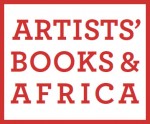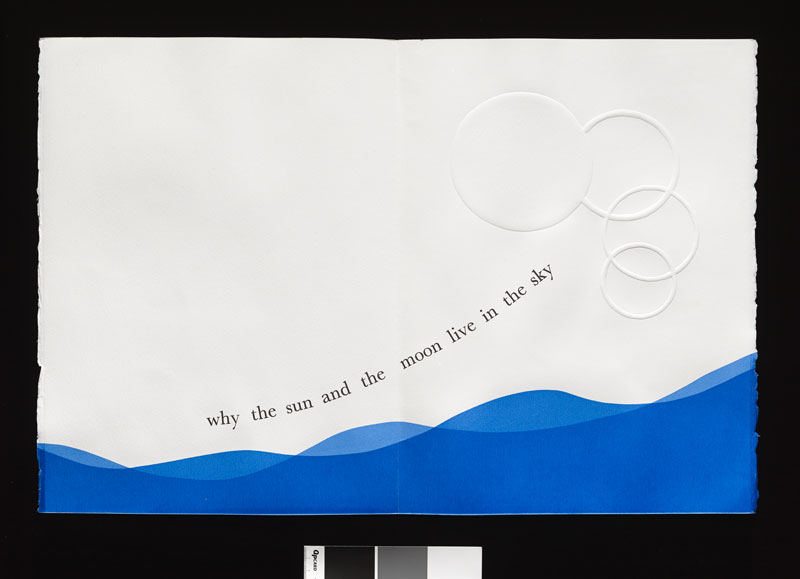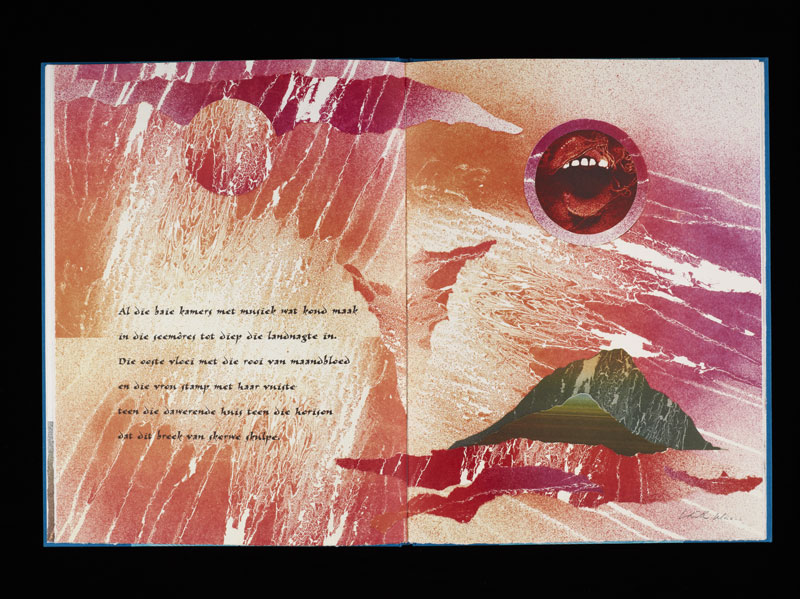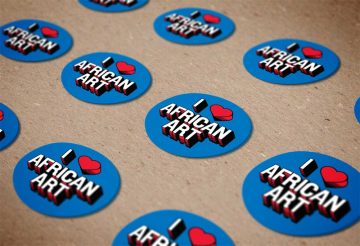Home | Elephant Folios | Artists’ Illustrated Books | Fine Press Editions | Exquisite Corpses | Accordion Folds | Gatefolds | Democratic Multiples | Multipart Books | Enclosures
 Fine press, or fine art, editions are distinguished by the high quality of materials and production. The weight of the paper, the binding, the hand-sewn signatures (sheets of folded pages), and the deckle-edged pages are hallmarks of high-end production. The typefaces and the page layouts are artistically designed. Even the colors of ink are carefully chosen.
Fine press, or fine art, editions are distinguished by the high quality of materials and production. The weight of the paper, the binding, the hand-sewn signatures (sheets of folded pages), and the deckle-edged pages are hallmarks of high-end production. The typefaces and the page layouts are artistically designed. Even the colors of ink are carefully chosen.
These are limited editions; only a few copies are made. They are usually numbered and signed by the artist and others who helped with the production. The copy number and the edition number are expressed as a fraction. For instance, 24/50 means the 24th copy of an edition of 50.
Collaborators in publishing fine art editions may include essayists, poets, printers, typesetters, binders, and papermakers.
Occasionally, an artist does it all, from A to Z.
For more information about fine press editions, click here.

Dates unknown, England
An African Folktale (detail)
Guildford, England: Circle Press Publications, 1979
Edition 62/200
Smithsonian Libraries
Arising from the blue water are the title words of this African folktale “Why the Sun and the Moon Live in the Sky.” In the story the Sun and his wife, the Moon, invite the Water and all the sea creatures into their house. Can you imagine the terrific flooding that forced poor Sun and Moon to flee into the sky? The words on the page rise upward as if on the same path that Sun and Moon fled.
Willow Legge beautifully brings to life this “why” story—a tale of the Efik peoples in Nigeria—with imaginative illustrations that invite you to feast your eyes and touch the pages.
Do you see those embossed circles in the sky?
For more information about An African Folktale, click here.

b. 1938, South Africa
Wilma Stockenström
b. 1933, South Africa
Skoelapperheuwel, Skoelappervrou (Butterfly Hill, Butterfly Woman) (detail)
Pretoria, South Africa: Ombondi Editions, 1988, 2010
National Museum of African Art, Smithsonian Institution, purchased with funds provided by the Annie Laurie Aitken Endowment, 2011-6-1
That gaping mouth. Could it signify pain from childbirth or intercourse?
“The woman bangs her fists against the booming house,” writes poet Wilma Stockenström.
The whole sinister landscape evokes trauma—magenta, orange, red.
“The east flows with red menstrual blood.”
Judith Mason’s lithograph of a collage of torn paper—marbled, sprayed, and painted—captures a woman’s agony.
Both the poem and the lithograph are ambiguous. The poem refers to impermanence and death. Mason’s imagery is a visual lamentation about life and death on Butterfly Hill.
A woman, her children, and a dog live in isolation in a drafty hilltop house. A bleak house, which abounds with butterflies. Butterfly Woman on Butterfly Hill.
For more information about Skoelapperheuwel, Skoelappervrou, click here.
